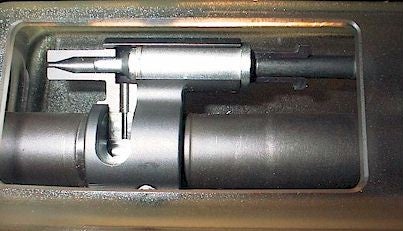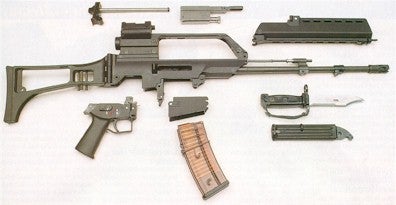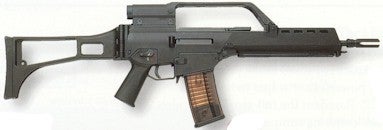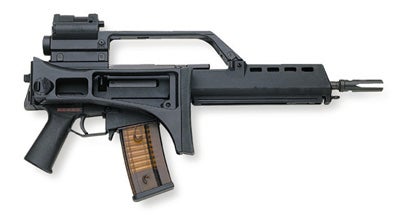Badger Arms
Member
In this post, I would like to make the case for the G36 rifle. The basis of my case is that the AR-15 rifle was adopted as an imperfect and underdeveloped rifle that, nevertheless, had many novel features. Many of these features were abandoned by Stoner and Armalite altogether as both technology and the understanding of firearms concepts increased. By 1980, technology existed to construct a rifle as good as the G-36 and yet the US Military chose to replace all of its rifles soon thereafter with a product improved version of an unrefined product.
Let's start with the similarities between the AR-15 and the G-36.
- Both use gas systems which involve loose tolerences and gas rings to seal the system. See the picture below.
- Both use lightweight composite plastic extensively.
- Both have Johnson-style bolts
- Both have in-line stocks
- Both have carry handles
The Differences are items I see as improvements.
- G36 utilizes optics, AR-15 uses iron sights
- G36 vents operating gas forward of gas block, AR-15 vents it into the action
- G36 uses ambidexterous charging handle/forward assist, AR-15 has ambi charging handle and right-handed forward assist added as an ugly afterthought
- G36 bolt rides on a single rod in-line with gas system with light weight spring, AR-15 uses very heavy spring, buffer system and bolt that bears on interior of aluminum receiver
- G36 has modular trigger group, fore-end, mag-well, and sight/carry handle, AR-15 has fixed mag well, trigger group, and some models have modular sighting system.
- G36 stock folds to the side significantly reducing size of weapon, AR-15 (M-4) has stock that telescopes only a short distance.
Here are the areas that probably should be improved in the G36:
- Fore-end should have heat-shields to prevent it from heating up. I prefer the M-4 style double-heat-shield.
- Trigger pull should be improved... significantly if the models I've examined are typical.
- Flip-up sights should be standard as a back-up to failure of the optical sights.
What I would like to know is that, from a design standpoint, why would it NOT be a good idea to adopt this rifle as standard issue for the United States? It's the best thing going...





Thanks to HK Pro for the above pictures.
Let's start with the similarities between the AR-15 and the G-36.
- Both use gas systems which involve loose tolerences and gas rings to seal the system. See the picture below.
- Both use lightweight composite plastic extensively.
- Both have Johnson-style bolts
- Both have in-line stocks
- Both have carry handles
The Differences are items I see as improvements.
- G36 utilizes optics, AR-15 uses iron sights
- G36 vents operating gas forward of gas block, AR-15 vents it into the action
- G36 uses ambidexterous charging handle/forward assist, AR-15 has ambi charging handle and right-handed forward assist added as an ugly afterthought
- G36 bolt rides on a single rod in-line with gas system with light weight spring, AR-15 uses very heavy spring, buffer system and bolt that bears on interior of aluminum receiver
- G36 has modular trigger group, fore-end, mag-well, and sight/carry handle, AR-15 has fixed mag well, trigger group, and some models have modular sighting system.
- G36 stock folds to the side significantly reducing size of weapon, AR-15 (M-4) has stock that telescopes only a short distance.
Here are the areas that probably should be improved in the G36:
- Fore-end should have heat-shields to prevent it from heating up. I prefer the M-4 style double-heat-shield.
- Trigger pull should be improved... significantly if the models I've examined are typical.
- Flip-up sights should be standard as a back-up to failure of the optical sights.
What I would like to know is that, from a design standpoint, why would it NOT be a good idea to adopt this rifle as standard issue for the United States? It's the best thing going...





Thanks to HK Pro for the above pictures.


